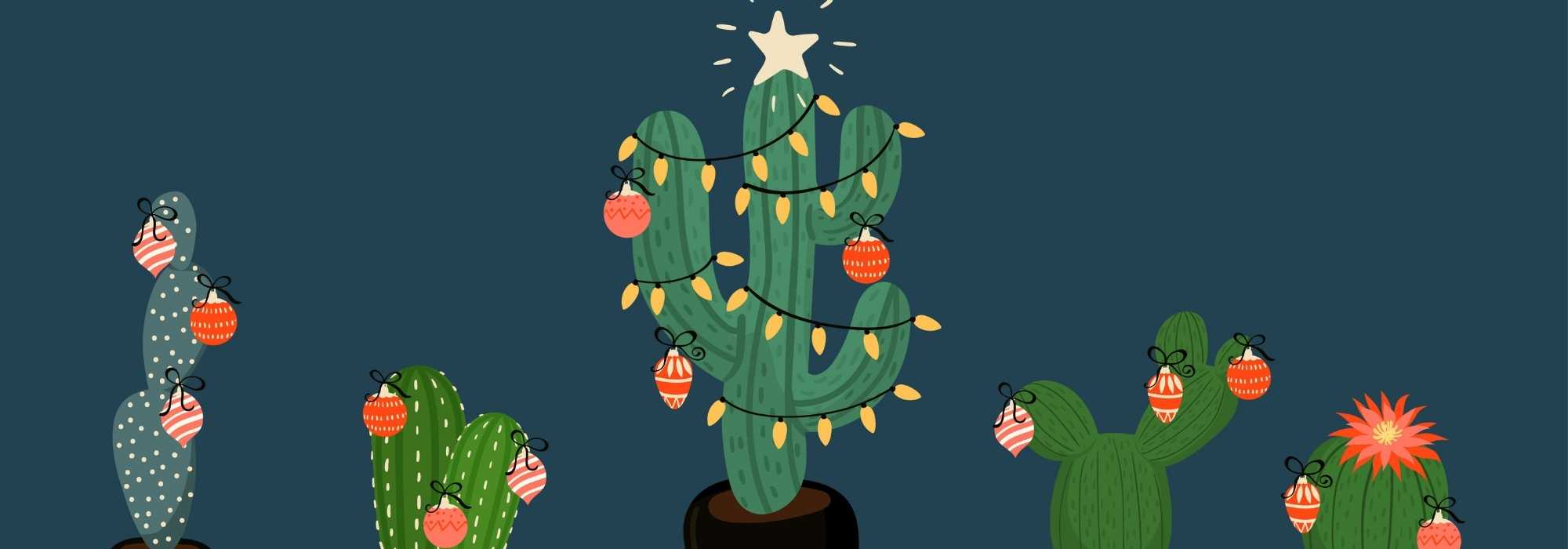
Our 7 alternatives to the Christmas tree
This year, we're replacing the Christmas tree!
Contents
Aren’t you a bit fed up with always seeing the same “Christmas trees” in our homes? From the classic spruce to the Nordmann fir, not to mention the Picea pungens, also known as the blue fir, we always see the same trees as soon as December rolls around. This year: let’s embrace originality! What if we chose different trees or bushes to decorate our interiors? Yes, but which ones? Small ones, graphic ones, bushes with changing foliage, rarities, or something more exotic. Discover our little selection of fun ideas.
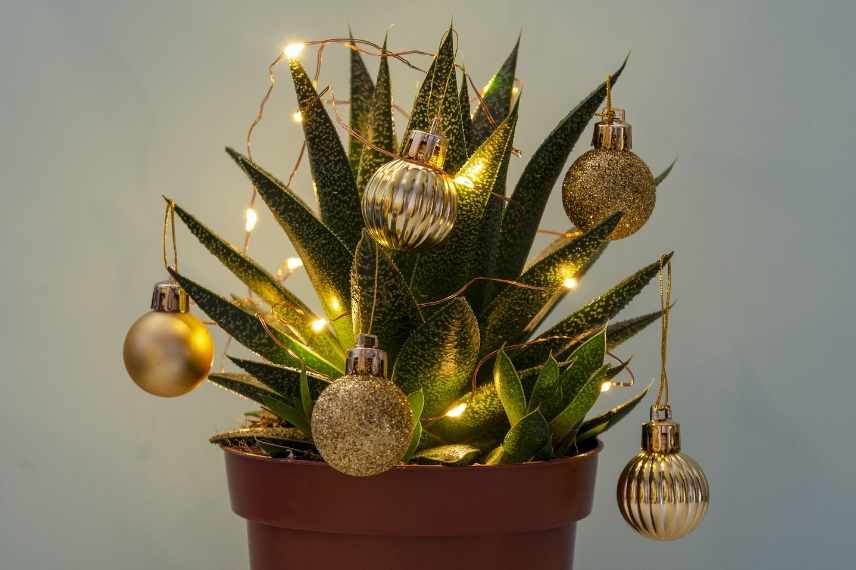 This year, it’s decided, we will have a… different Christmas tree…!
This year, it’s decided, we will have a… different Christmas tree…!
To start with
The idea here is to find original alternatives to replace the traditional Christmas tree with an outdoor plant. Therefore, these trees and bushes should either be planted directly in the garden or kept in pots outside, or maintained during the festivities in a cool, not too dry room. A conservatory, for example. These bushes should only be kept for the duration of the festivities and planted as soon as spring arrives.
At the end of the article, however, the editorial team will provide you with some ideas for indoor plants that can serve as a temporary Christmas tree.
Abies koreana 'Silberlocke'
You might be thinking: “but they must be joking at Promesse de fleurs. To replace a fir tree, they offer us… a fir tree!“
True, but not just any fir. The Abies koreana ‘Silberlocke’ is a Korean fir that appears to be naturally covered in snow. Its curved needles with silver undersides contrast beautifully with the glossy green of the other side. This conifer, more of a bush with a pyramidal habit, has a slow growth rate and displays cones that start off a soft green before turning a dusty blue-violet or grey-purple at maturity.
In the garden: the Korean fir is quite hardy, enjoys ordinary but well-drained soil, even stony and rocky, enriched with humus, not too dry, in dappled sunlight or partial shade. This species is sensitive to heat and scorching sun.

Abies koreana ‘Silberlocke’
Ilex aquifolium 'Myrtifolia'
A simple holly! The Ilex aquifolium or Common Holly is the most striking plant symbol of the festive season. The variety Ilex aquifolium ‘Myrtifolia’ is quite special and more ornamental than the typical species. This bush has finely cut, narrow evergreen foliage, a sparkling dark green under the sun with very finely serrated edges. This bush has a compact, slender conical habit and is a male cultivar, which unfortunately does not produce any fruits.
In the garden: this Common Holly is very hardy and prefers acidic, humus-bearing, deep soils and cool situations.
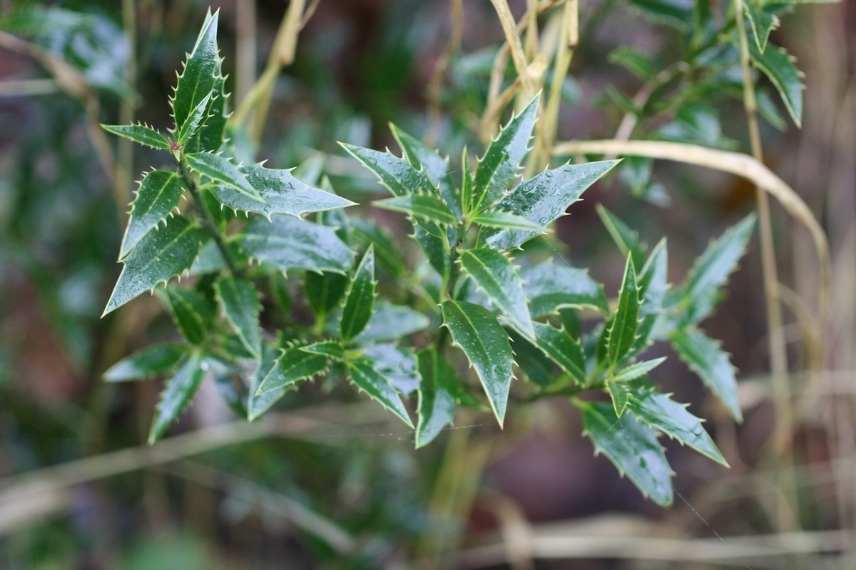
Ilex aquifolium ‘Myrtifolia’
Eucalyptus gunnii 'France Bleue'
Step off the beaten path with this Eucalyptus gunnii ‘France Bleue’. It is a lovely little bush with a well-ramified, evergreen foliage. Its fine, blue-hued leaves contrast beautifully with its young brown-red shoots. With its blue leaves, it will make a statement, adorned with small red balls. Modestly sized, this bush displays a habit that is both ramified and light, particularly elegant.
In the garden: The Eucalyptus gunnii ‘France Bleue’ ‘Rengun’ should be planted in well-drained, dry soil, in a warm and sunny location, but sheltered from strong, cold winds. It is worth noting that it is moderately hardy: -10 °C. In a mild climate, you can plant it in the ground, but it also grows very well in pots, which should be quite large and filled with a light, rich substrate.
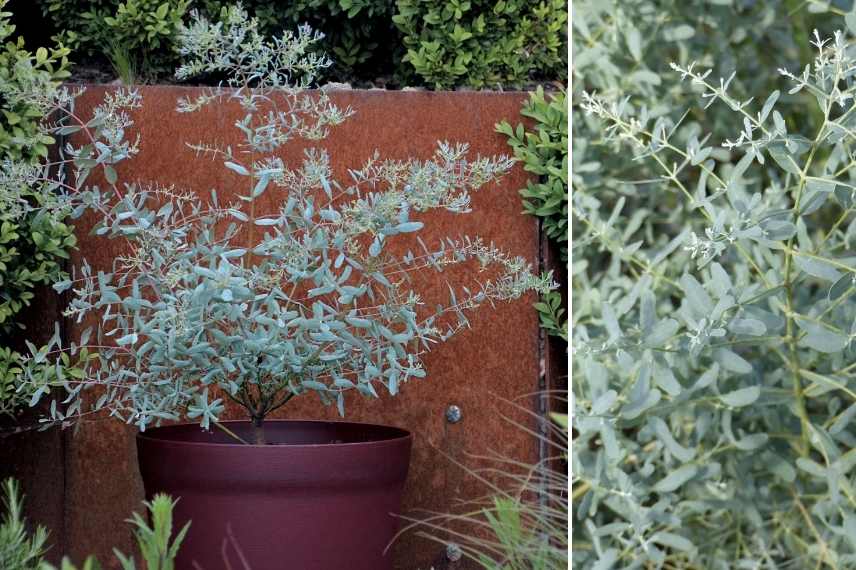
Eucalyptus gunnii ‘France Bleue’
Japanese Spindle 'Paloma Blanc'
What do you think of a little ball of evergreen leaves covered in “snow”? The young shoots of the remarkable Japanese spindle ‘Paloma Blanca’ are of immaculate whiteness, creating a striking contrast with the old dark green, glossy foliage. Gradually, these white leaves turn cream, then light green, and finally dark green. This cultivar has a slow growth rate and its habit is naturally very bushy and upright. This Euonymus japonicus is ideal for creating miniature hedges along paths or terraces, or for pot cultivation.
In the garden: this cute little bush will thrive in light shade, in ordinary soil, even calcareous, but remaining cool. Be careful, it is only hardy down to -12 °C, but it is sensitive to overly hot and dry climates.

Euonymus japonicus ‘Paloma Blanca’ (© Plantipp)
Gaultheria procumbens
If you are looking for a “miniature” version to decorate a table, this little carpet bush is the perfect solution. Moreover, it is already adorned for the festivities! Yes, thanks to its small red fruits. The Gaultheria procumbens or Creeping Wintergreen is very useful for filling gaps at the base of shrubs, especially in heather soil beds. The dense dark green foliage takes on purplish hues as temperatures drop in autumn. Its lovely shiny berries turn red by the end of summer and persist on the bush until spring.
In the garden: very hardy, the wintergreen prefers acidic to neutral soil, in shade or partial shade. A mulch of pine bark or needles will be perfect to keep its roots cool. It can be grown in pots or used to decorate window boxes during winter.
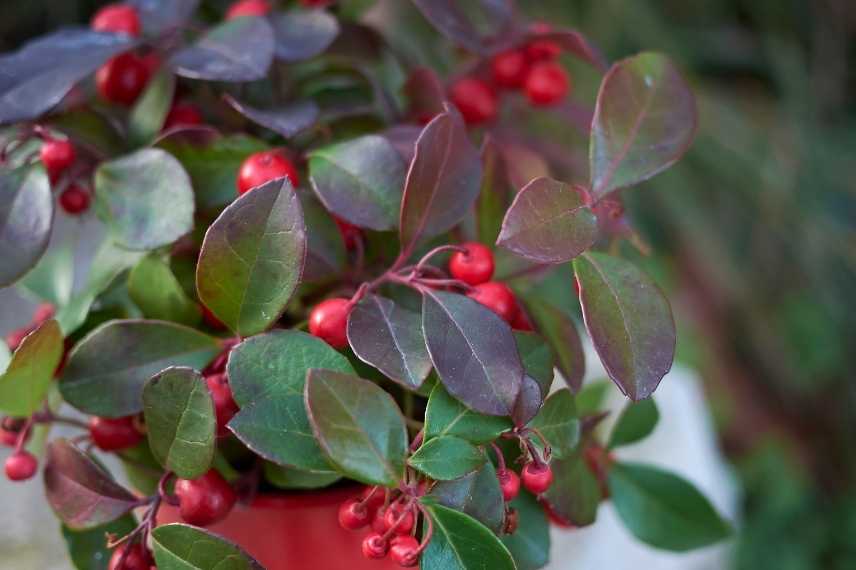
Gaultheria procumbens
Lonicera nitida 'Silver Beauty'
Here is a bush that is completely “frosted“! A great way to brighten up the festive season. The Lonicera nitida ‘Silver Beauty’ is an evergreen honeysuckle whose green leaves marginate with white give it a silvery appearance. Easy to grow, it is a dense, bushy shrub that offers an interesting alternative to boxwood.
In the garden: Quite hardy, this Lonicera prefers a consistent but well-drained, deep and cool, even calcareous soil, in partial shade or light sun. The Box-leaved Honeysuckle ‘Silver Beauty’ is perfect for creating low to medium hedges. It can also be shaped into topiaries, planted in pots on a terrace, trained on a trellis, or left to grow freely in woodland.
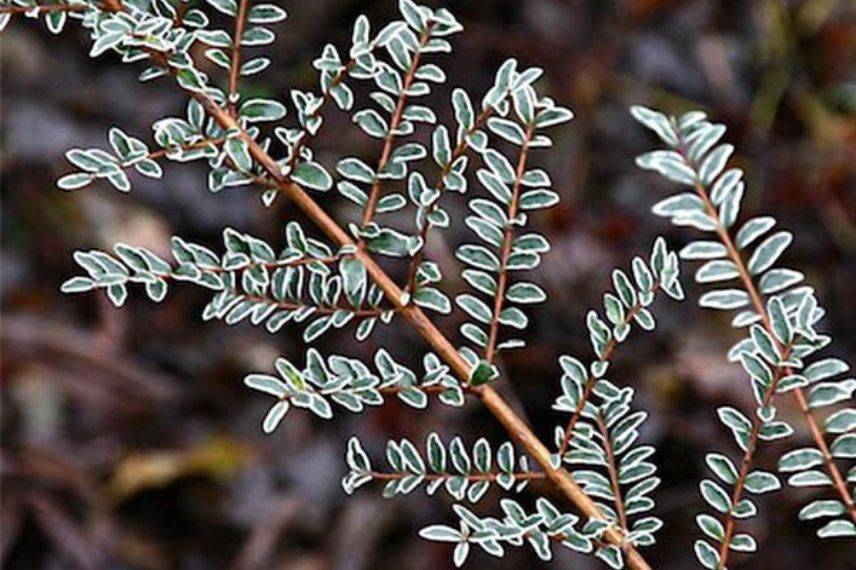
Lonicera nitida ‘Silver Beauty’
Nandina domestica 'Obsessed Seika'
The Nandina domestica ‘Obsessed Seika’ has more than one asset in its branches. The semi-evergreen foliage is light and changes colour throughout the seasons: successively bright red in spring, then green in summer, finishing with purple in autumn. This modestly sized bush, with a very graphic habit, bears fruit for almost the entire year, as last year’s berries accompany the summer flowering, which is itself followed by new intensely red berries.
In the garden: sufficiently hardy, heavenly bamboo enjoys soft, deep, well-drained soils, even slightly calcareous, ideally kept cool throughout the year. The Nandina domestica prefers sunny but not scorching situations or partial shade. It can be planted alone, in a border, or as a free-standing hedge, but also in a large pot.
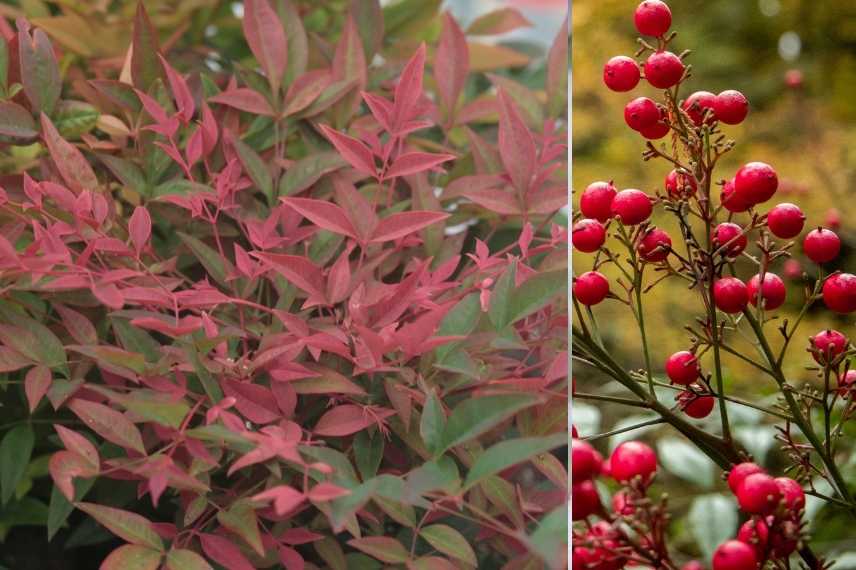
Nandina ‘Obsessed Seika’
The crazy ideas of the editorial team
If nothing in this little selection appeals to you, you can always draw inspiration from the slightly crazy ideas of the writers at Promesse de Fleurs.
- Aurélien suggests his traditional “Christmas rubber tree”. Nothing to do with the material, it’s actually a Ficus elastica, an indoor plant that will be adorned with garlands or other baubles. In fact, I shared my office in December for a few years with a Christmas Ficus, a rather bare Ficus benjamina.
- Pascal talks about a living garland: a Philodendron scandens, a climbing indoor plant with long, flexible stems. An ideal liana to hang baubles or other decorations.
- Virginie, on the other hand, takes on a “Grinch” mode with succulents or slightly… prickly cacti. Like agaves or opuntias. After all, why not? Let’s remember Gaston Lagaffe, who entertained us with a few gags related to his “Christmas cactus”.
- Meanwhile, Marion, more understated, decorates her rosemary plants every year. The perfect combination of the useful and the pleasant!
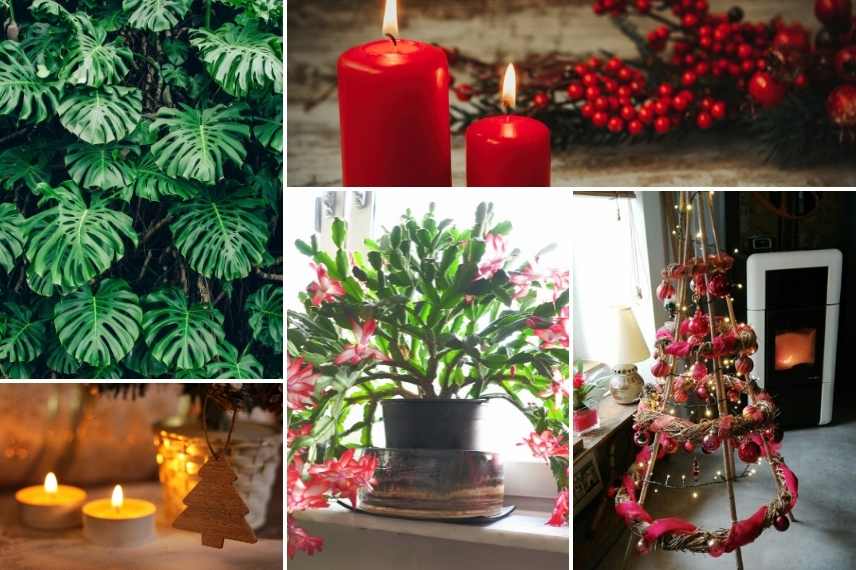 Indoor plants with “notched” foliage to hang baubles, Christmas cactus… or a homemade display (© I. Brau)… It’s your turn to play!
Indoor plants with “notched” foliage to hang baubles, Christmas cactus… or a homemade display (© I. Brau)… It’s your turn to play!
For further reading
- Discover Olivier’s gift ideas for a successful Christmas stocking 2021
- Subscribe!
- Contents
































Comments